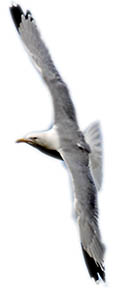The Battle of Towton
29th March 1461
Bloodcurdling cries of battle, emerging harrowingly through chill mists of time and obscurity, assail our senses now. Harsh clatter, of steel upon steel, grabs our attention; punctuated by the forlorn screams of mortally wounded men. Reaching a crescendo on Palm Sunday 2011, when thousands of folk gather, on the now peaceful killing fields of Towton, to commemorate the anniversary of the bloodiest battle ever fought on English soil. They remember the thousands of poor, tortured souls that perished so brutally here, five hundred and fifty years ago.
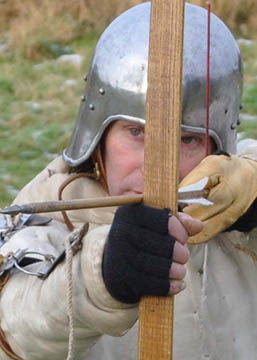
The Battle of Towton was to prove a crucial turning point in the ‘Cousins War’ as the Battle of the Roses was known in the 15th century. The war had been rumbling on for decades as the two rival families, the Lancastrians and the Yorkists, fought for supremacy and the throne of England.
Richard, Duke of York, father of Edward, head of the Yorkist army, had been defeated and killed on the battlefield at Wakefield just three months before on the penultimate day of 1460. It almost seems that both factions had decided they would come together at the Battle of Towton to settle the matter – the hard way!
Up to 100,000 men turned up, each with a single thought – kill as many of the enemy as possible. In the event, it is estimated that 28,000 souls perished on that cold, blizzard-whipped battlefield and the surrounding area. The remnants of the Lancastrian forces, nobleman and common soldier alike were routed and slaughtered mercilessly by the Yorkists seeking revenge for the Battle of Wakefield.
The turmoil saw father kill son and brother kill brother as Englishman fought Englishman to the death. I have seen a very moving picture depicting a father kneeling beside the slain body of his son in the aftermath of the battle. Grief is etched on his face as he realises he was the one who had struck the young man down.
The battle raged for ten hours and the fortunes of war surged back and forth throughout the day. For a time the day seemed to belong to the Lancastrians as they pushed the Yorkists back towards the River Aire to the south. Only to be thwarted by the late arrival of the Duke of Norfolk with 5,000 fresh men to save the day for Edward and his Yorkist army. Edward, the victor, was later crowned King Edward IV in London.
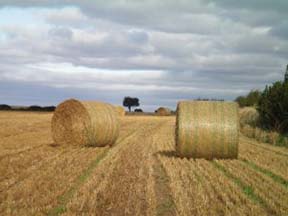
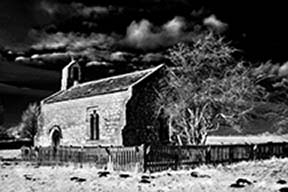
Today, the fields between Towton and Saxton are peaceful and quiet. The battle tree, seen between the two rolls of hay in the picture remains as the centre point of the battle.
The Lead church provided refuge for some of the soldiers on that freezing cold day. It must have appeared very much as it does in the picture.
Towton Battlefield Society
The Battle of Towton has its own ‘fan club’ in the Towton Battlefield Society whose own web site can provide many more details of this most turbulent of times in the history of Yorkshire.
I asked George Peter Algar, author of the delightful novel The Shepherd Lord and a member of the Towton Battlefield Society about the society and preparations for the event…
‘Towton Battlefield Society is a voluntary organisation that works with the community to promote knowledge of the Battle of Towton and helps preserve the integrity of the battlefield. A new battlefield footpath has been laid out and by Palm Sunday, we should have all the battlefield interpretation boards in-situ. At other times we offer guided tours for interested parties. Our web site has details.
Visitors to the battlefield will find a warm welcome for refreshments and pitstop at the Rockingham Arms at Towton and the Crooked Billet at the village of Lead, near Saxton.’
Follow this link to visit Towton Battlefield Society
I have read and thoroughly enjoyed the book, The Shepherd Lord written by George Peter Algar. A story of the flight and concealment of the two young sons of Lord John Clifford after his death in the Battle of Towton. For fear of reprisals, John’s heir Henry Clifford was brought up as a lowly shepherd boy until it was safe to reclaim his inheritance. Follow this link The Shepherd Lord to read my review of the book.
The book Walk Towton 1461 written by Helen Cox and Alan Stringer describes in detail the walk around the battlefield at Towton along with details of other battle and skirmish sites leading up to this cataclysmic event. To read my review of Walk Towton 1461 click the link.
Please note: All images in the centre column of this page and above this point, published with kind permission, are copyright Towton Battlefield Society. They may not be reproduced without their permission. In particular the picture of Lead Church copyright belongs to Rae Tan and the picture of the longbow archer is shown here courtesy of Mike Wilson.
Battle of Towton 550th Anniversary
An incredibly exciting day was enjoyed by thousands of visitors to the 550th anniversary commemoration of the Battle of Towton on Palm Sunday 2011. The event was blessed with glorious warm, sunny weather and the huge field laid aside for car parking was soon filled.
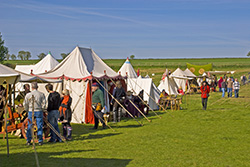
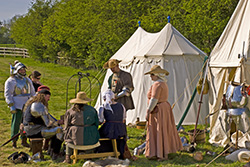
A festival atmosphere prevailed as crowds of visitors wandered through the medieval encampment. Here, convincingly attired in medieval costume, enthusiastic groups of people displayed and explained beautifully reproduced everyday items of the period. We saw remarkably delicate tassels and beading of silk used to decorate and brighten up the otherwise mundane and probably grubby clothing of ordinary folk. Intriguing early timepieces caught my eye. Crossbows and English longbows were displayed alongside very early cannon and firearms.
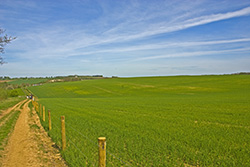
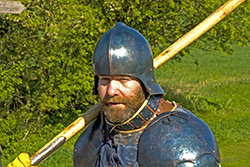
Throughout the morning, groups of people followed knowledgeable guides on a walk around part of the battlefield. Brief stops were made to allow stragglers to catch up. The stops were enlivened with the guide’s interesting historical details of the period before and after the battle – and indeed, why the battle took place at all! We were encouraged to imagine the scene, all those years ago, as the blizzard swept this bleak landscape. The Lancastrian army was eventually trapped by the lay of the land and routed attempting to flee the hell of the battlefield across the heavily swollen Cock Beck towards Tadcaster and York.
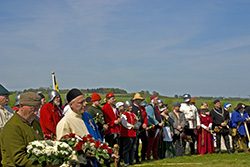
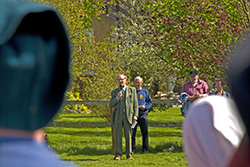
One o’clock saw the grassland by Towton Hall filled with visitors and fifteenth century soldiers and their womenfolk and children. They had gathered for a service of memorial to all who fought and died on that Palm Sunday so very long ago. Before the service began the gathering was addressed by the chairman of the Battle of Towton Society and also by their patron, actor Robert Hardy.
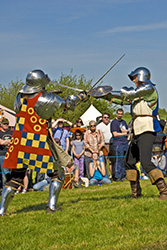
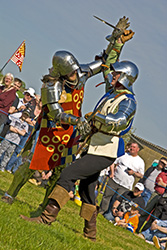
The crowds were treat, throughout the afternoon, to displays of falconry, arming the Knight and English fifteenth century combat. Archery and gunnery featured in a Firepower Show. To remind us we were not the only ones engaged in fighting in those long-ago times there was a Gatka Show – a demonstration of medieval Sikh martial arts.
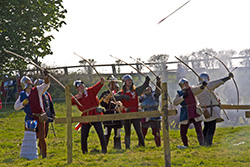
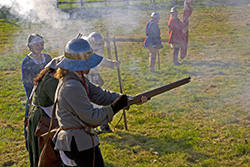
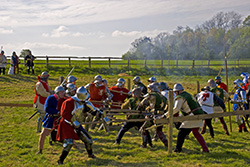
Magnificently rounding off a brilliant day was a re-enactment of the Battles of Ferrybridge and Dintingdale – the thrilling and noisy last stand of Lord John Clifford of Skipton.

The battle is remembered each year on Palm Sunday. But this was an extra special event marking the five hundred and fifty years that have past since that bloodiest and most gruesome day in 1461.

